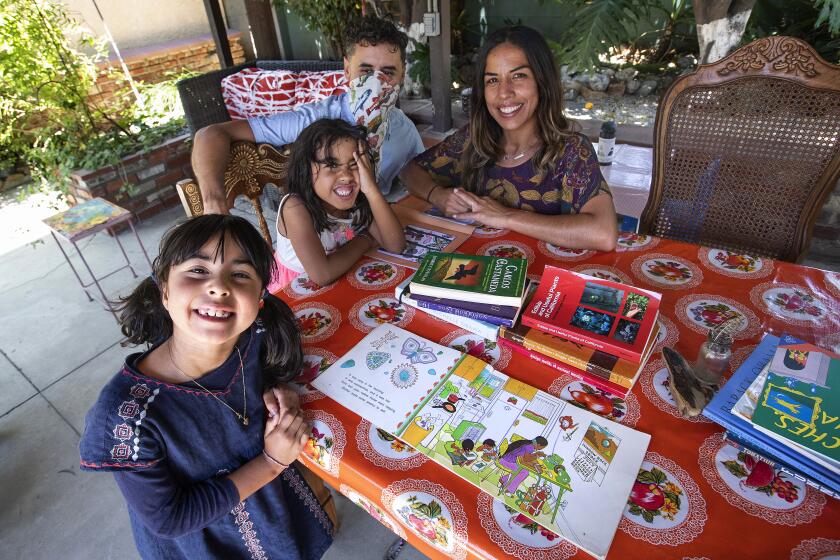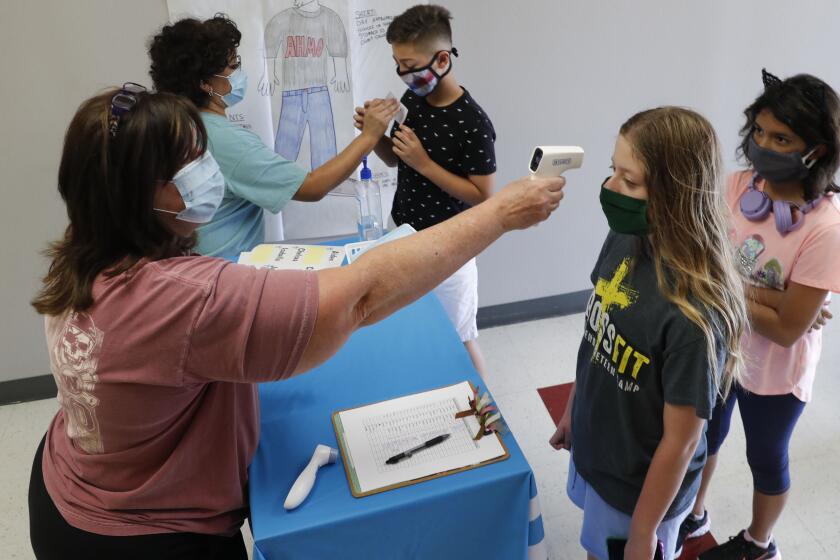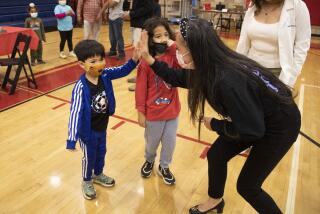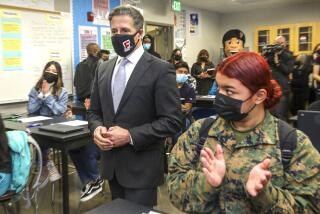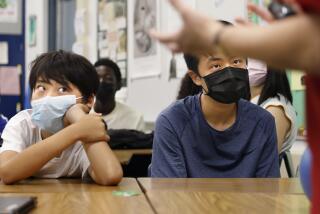Schools may soon apply for waivers to reopen — but only with union support
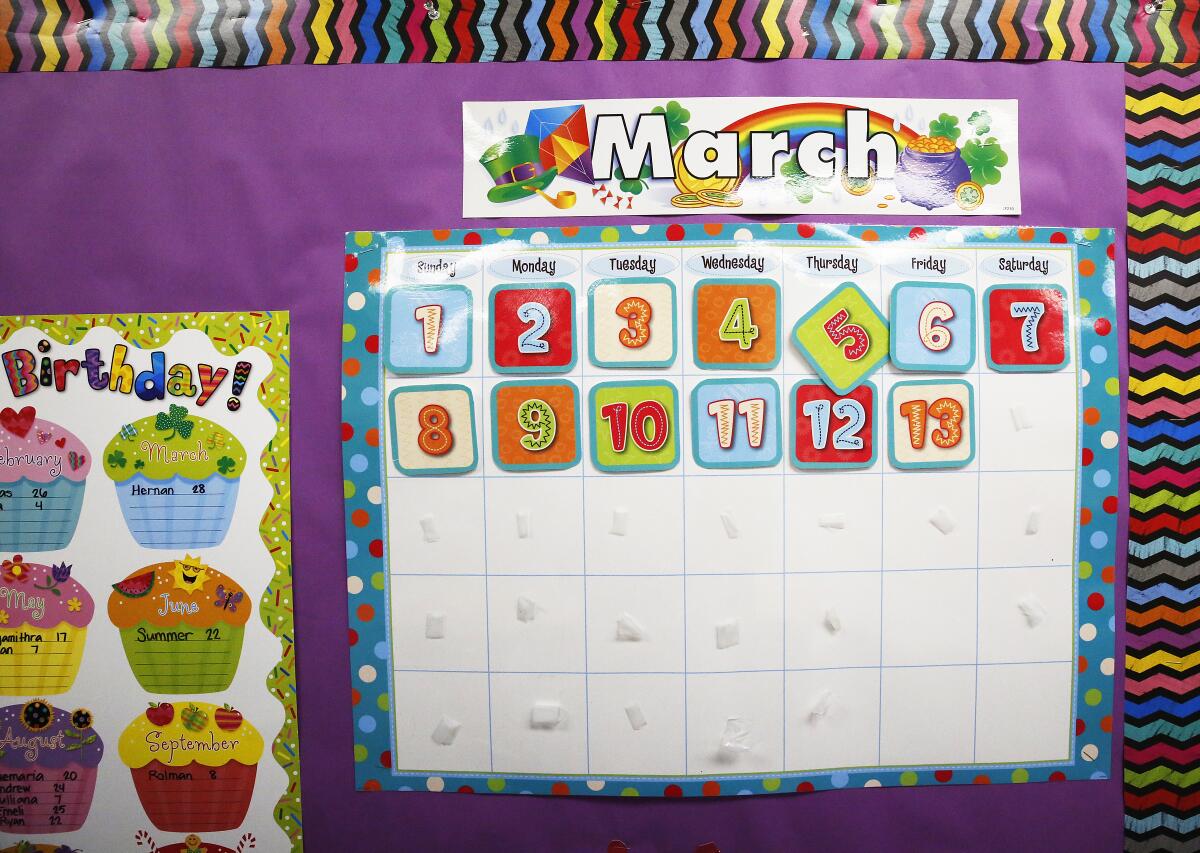
- Share via
School districts, charters and private schools in L.A. County may begin applying within days for waivers that would allow them to reopen elementary schools in person — but public schools will have to show they have union support, county public health officials said Thursday.
The requirement to show union support will likely give some charters and private schools — most of whose teachers are not unionized — an advantage in qualifying for a waiver, potentially exacerbating the divide between well-off students and their more disadvantaged peers, which has only grown during the COVID-19 pandemic.
Some also said it would needlessly politicize the process.
“If the L.A. [County Department of Public Health] wants to use science and data to determine the merit of a waiver, then I can support that,” Supt. Alex Cherniss of the Palos Verdes Peninsula Unified School District said in an emailed statement.
“But to require a letter of support from parent organizations and labor unions seems outside of the scope of their responsibility and veers off from science to politics. It would not only pit parents, teachers and school districts against each other, but it would also create an unfair ability for private schools.”
Frantic parents with resources are rushing to hire tutors and form learning pods to bring distance learning to their homes and backyards amid coronavirus school closures.
In an emailed response to questions, the Public Health department said it is “working on designing the application process to be in compliance with state requirements.” It did not specify whether private schools and charters would have to show some form of parent or teacher support as well.
Gov. Gavin Newsom announced last week that schools in counties that are on the state’s monitoring list — 32 counties as of the announcement — may not physically open for in-person instruction until their county has come off the list for 14 consecutive days.
He said the only exception would be for elementary schools that apply for waivers through their health officers, who must consider local data and consult with the California Department of Public Health when reviewing the request.
Districts may apply for a waiver to reopen only for in-classroom instruction for students in transitional kindergarten through 6th grade.
The waiver application must include letters of support from all labor partners, parent organizations and community-based organizations that provide educational services for children in the district, the department said.
In addition, districts must complete a “reopening protocol checklist” documenting steps that will be in place to ensure that public health directives are followed, including a plan for managing outbreaks, testing strategy for employees, and requirement that everyone over 2 years of age wear face coverings while on school campuses.
The county public health department would then review and provide superintendents with trend data for their area, including number of cases, number of deaths and changes in case and death rates over the past month. It would also evaluate capacity at regional hospitals and, together with the state department of public health, assess each district’s risk and preparedness for reopening safely in determining whether to grant the waiver.
“We’re going to do our best to use the available data and the science to ensure that the health and well-being, both physical and emotional, of all children, teachers, school staff and all of their families remains the top priority,” county Public Health Director Barbara Ferrer said at a news conference Wednesday during which she discussed the waivers.
Joshua Sharfstein, a professor of health policy at Johns Hopkins University, said it is prudent to reopen schools slowly.
“California is going through this in a very thoughtful way because they’re making those first set of schools go through an extra set of hoops — so hopefully you can learn from them before you open more widely,” he said.
Beginning with younger students makes sense, too, he said.
“They appear to benefit the most from in-person schooling, and they appear to be at somewhat less risk for transmitting the virus,” Sharfstein said. “Both the value and the risk point in the direction of younger kids being able to go to school.”
He said that health officials should grant waivers based on a combination of the local circumstances and the protections that can be put into place — and then track what happens.
“There’s a lot we still don’t know,” Sharfstein said. “You still want to see how it’s going.”
Here’s what scientists know about kids’ potential to spread the coronavirus and the risks of sending them back to school amid the COVID-19 pandemic.
Debra Duardo, L.A. County’s superintendent of schools, said districts “are really eager” to bring students back if they can do so safely. She said many have talked about wanting to serve students that have been the most disconnected and had the most challenges with distance learning, such as those with disabilities, foster youth and homeless students.
She said the union requirement is “definitely a challenge.”
“I’m hoping that maybe when the Department of Public Health looks at the specific data closest to that school, maybe some union members will feel more comfortable,” she said. “It is going to be a challenge for districts if their teachers feel their own health is going to be at risk.”
Some districts, including those that serve low-income and wealthier families, said they would not apply for a waiver despite being given the option. One superintendent whose district serves primarily low-income families said its teachers association is concerned about members’ safety and the county’s current status as a COVID-19 hot spot.
Another, Palmdale School District Supt. Raul Maldonado, said his district was placing all its efforts into distance learning for the time being but might consider a waiver as the situation improves.
“Reopening school is not like opening a gym or a restaurant,” he said. “There is a lot of planning that needs to be done.”
Melissa Moore, superintendent of El Segundo Unified School District, also said meeting the criteria for a waiver “is not as simple as filling out a form.”
“With the current metrics on COVID-19 in L.A. County, the safety of students and staff need to remain nonnegotiable before moving forward with submitting a waiver,” she said.
More to Read
Sign up for Essential California
The most important California stories and recommendations in your inbox every morning.
You may occasionally receive promotional content from the Los Angeles Times.
